Attached files
| file | filename |
|---|---|
| 8-K - FORM 8-K - PNC FINANCIAL SERVICES GROUP, INC. | d8k.htm |
| EX-99.1 - FINANCIAL SUPPLEMENT (UNAUDITED) FOR FIRST QUARTER 2011 - PNC FINANCIAL SERVICES GROUP, INC. | dex991.htm |
 The PNC
Financial Services Group, Inc. First Quarter 2011
Earnings Conference Call
April 21, 2011
Exhibit 99.2
*
*
*
*
* |
 2
Cautionary Statement Regarding Forward-Looking
Information and Adjusted Information
This
presentation
includes
“snapshot”
information
about
PNC
used
by
way
of
illustration.
It
is
not
intended
as
a
full
business
or
financial
review
and
should
be
viewed
in
the
context
of
all
of
the
information
made
available
by
PNC
in
its
SEC
filings.
The
presentation
also
contains
forward-looking
statements
regarding
our
outlook
or
expectations
for
earnings,
revenues,
expenses,
capital
levels,
liquidity
levels,
asset
quality
and/or
other
matters
regarding
or
affecting
PNC
and
its
future
business
and
operations.
Forward-looking
statements
are
necessarily
subject
to
numerous
assumptions,
risks
and
uncertainties,
which
change
over
time.
The
forward-looking
statements
in
this
presentation
are
qualified
by
the
factors
affecting
forward-looking
statements
identified
in
the
more
detailed
Cautionary
Statement
included
in
the
Appendix,
which
is
included
in
the
version
of
the
presentation
materials
posted
on
our
corporate
website
at
www.pnc.com/investorevents.
We
provide
greater
detail
regarding
some
of
these
factors
in
our
2010
Form
10-K,
including
in
the
Risk
Factors
and
Risk
Management
sections
of
that
report,
and
in
our
subsequent
SEC
filings
(accessible
on
the
SEC’s
website
at
www.sec.gov
and
on
or
through
our
corporate
website
at
www.pnc.com/secfilings).
We
have
included
web
addresses
here
and
elsewhere
in
this
presentation
as
inactive
textual
references
only.
Information
on
these
websites
is
not
part
of
this
presentation.
Future
events
or
circumstances
may
change
our
outlook
or
expectations
and
may
also
affect
the
nature
of
the
assumptions,
risks
and
uncertainties
to
which
our
forward-looking
statements
are
subject.
The
forward-looking
statements
in
this
presentation
speak
only
as
of
the
date
of
this
presentation.
We
do
not
assume
any
duty
and
do
not
undertake
to
update
those
statements.
In
this
presentation,
we
will
sometimes
refer
to
adjusted
results
to
help
illustrate
the
impact
of
certain
types
of
items,
such
as
our
third
quarter
2010
gain
related
to
the
sale
of
PNC
Global
Investment
Servicing
Inc.
(“GIS”).
This
information
supplements
our
results
as
reported
in
accordance
with
GAAP
and
should
not
be
viewed
in
isolation
from,
or
a
substitute
for,
our
GAAP
results.
We
believe
that
this
additional
information
and
the
reconciliations
we
provide
may
be
useful
to
investors,
analysts,
regulators
and
others
as
they
evaluate
the
impact
of
these
respective
items
on
our
results
for
the
periods
presented
due
to
the
extent
to
which
the
items
are
not
indicative
of
our
ongoing
operations.
We
may
also
provide
information
on
pretax
pre-provision
earnings
(total
revenue
less
noninterest
expense),
as
we
believe
that
pretax
pre-provision
earnings,
a
non-GAAP
measure,
is
useful
as
a
tool
to
help
evaluate
the
ability
to
provide
for
credit
costs
through
operations.
Where
applicable,
we
provide
GAAP
reconciliations
for
such
additional
information.
In
certain
discussions,
we
may
also
provide
information
on
yields
and
margins
for
all
interest-earning
assets
calculated
using
net
interest
income
on
a
taxable-equivalent
basis
by
increasing
the
interest
income
earned
on
tax-exempt
assets
to
make
it
fully
equivalent
to
interest
income
earned
on
taxable
investments.
We
believe
this
adjustment
may
be
useful
when
comparing
yields
and
margins
for
all
earning
assets.
We
may
also
use
annualized,
proforma,
estimated
or
third
party
numbers
for
illustrative
or
comparative
purposes
only.
These
may
not
reflect
actual
results.
This
presentation
may
also
include
discussion
of
other
non-GAAP
financial
measures,
which,
to
the
extent
not
so
qualified
therein
or
in
the
Appendix,
is
qualified
by
GAAP
reconciliation
information
available
on
our
corporate
website
at
www.pnc.com
under
“About
PNC–Investor
Relations.” |
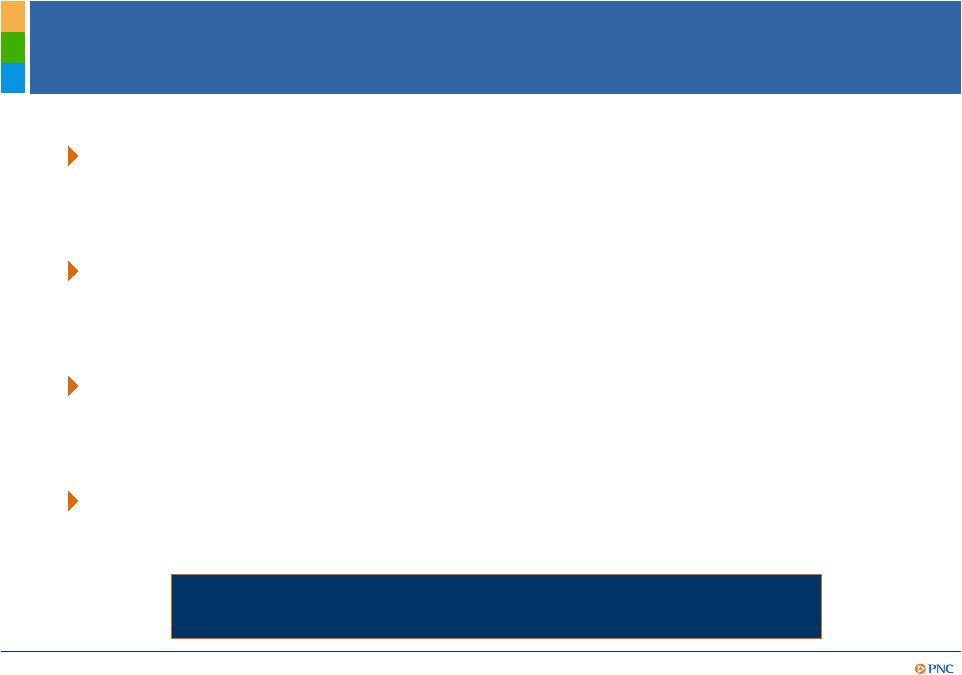 3
Today’s Discussion
1Q11 strategic achievements –
strong results and
capital actions
Building momentum in our businesses –
client
growth and new product launches
Key financial take-aways –
strong balance sheet,
strong earnings and solid returns
2011 outlook remains positive
PNC Continues to Build a Great Company.
PNC Continues to Build a Great Company. |
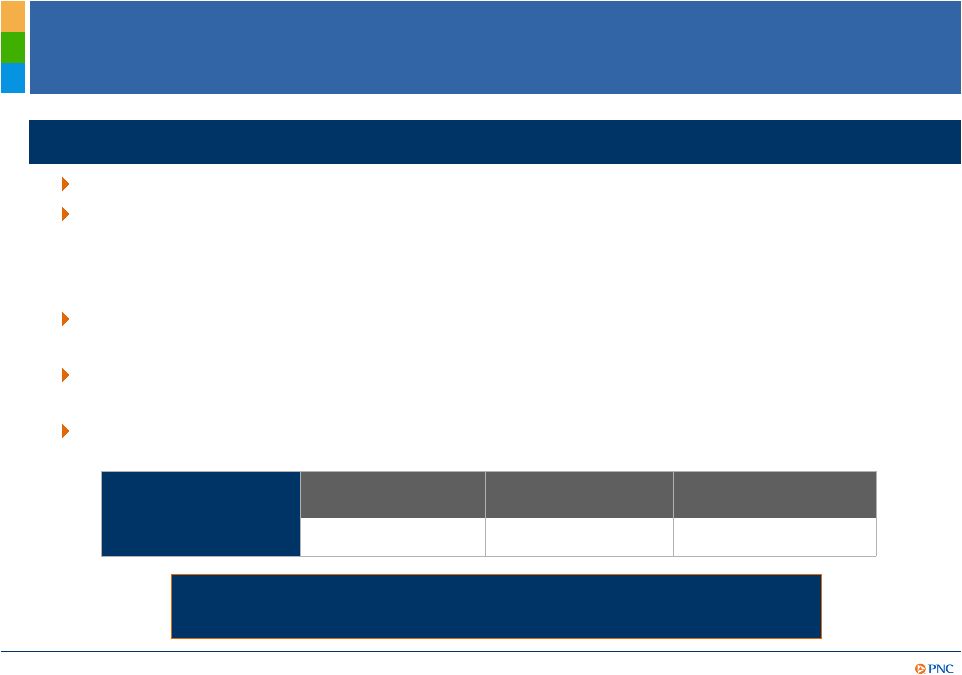 4
Significant 1Q11 Achievements
PNC Is Positioned to Deliver Even Greater Shareholder Value.
PNC Is Positioned to Deliver Even Greater Shareholder Value.
1Q11 financial
summary
Net income
Diluted EPS from
net income
Return on
average assets
$832 million
$1.57
1.29%
Delivered strong financial results through the execution of our business model
Record capital levels
-
Increased quarterly common stock dividend 250% to $0.35 per share for 2Q11
-
Confirmed 25 million share repurchase program; plan to repurchase up to $500
million
in
2011
Businesses continued to grow clients, deepen relationships and launch new
products
Continued to maintain a high quality balance sheet, poised to support client
growth
Actively managed our risk positions toward a moderate profile
1Q11 highlights
(1) Subject to market and general economic conditions, economic and regulatory capital
conditions, alternative uses of capital, regulatory and contractual limitations, and
potential impact on credit ratings. 1 |
 5
Focused on Growing Our Businesses
Retail Banking
Corporate & Institutional Banking
Asset Management
Residential Mortgage
Grew checking relationships by 56,000
during 1Q11
Reached a definitive agreement to acquire 19
branches and approximately $350 million of
deposits from BankAtlantic Bancorp in the
Tampa, Florida area
1
Launched new deposit products line-up and
new credit card products
Beginning to see growth in loans and
commitments and increased utilization
-
Average loans increased $1.2 billion in 1Q11
vs. 4Q10
On track to reach goal of adding 1,000 new
clients in 2011
Good pipeline activity in treasury management,
M&A advisory and syndications
Grew assets under administration to $219
billion at March 31, 2011
Continued aggressive hiring to drive growth
across the footprint
Investing in innovation and technology –
piloting Wealth Insight tool
Loan originations of $3.2 billion up 60% from
1Q10, but down from 4Q10
1Q11 servicing fees up 9% and loans sales
revenue up 27% vs. 4Q10
Positive operating leverage
2
(1) Subject to customary closing conditions. (2) A period to period dollar or percentage
change when revenue growth exceeds expense growth. PNC is a 2011 Gallup Great Workplace
Award Winner. PNC is a 2011 Gallup Great Workplace Award Winner.
|
 6
Financial Performance
Strong
Earnings
1Q11
4Q10
1Q10
Net income ($
millions) $832
$820
$671
Earnings per diluted share
$1.57
$1.50
$0.66
Valuation
Drivers
1Q11
4Q10
1Q10
Tier 1 common capital ratio¹ 10.3%
9.8%
7.9%
Book value per common share
$58.01
$56.29
$50.32
Operating
Leverage
1Q11
4Q10
1Q10
Revenue ($
millions) $3,631
$3,903
$3,763
Provision ($
millions) $421
$442
$751
Noninterest expense
($ millions)
$2,070
$2,340
$2,113
Performance
Measures
1Q11
4Q10
1Q10
Return on average assets
1.29%
1.23%
1.02%
Return
on
Tier
1
common
capital
1,3
15.4%
15.4%
15.5%
(1)
1Q11
Tier
1
common
capital
ratio
is
estimated.
(2)
At
period
end.
(3)
Return
on
Tier
1
common
capital
calculated
as
annualized
net
income
divided
by
Tier
1
common
capital.
Further
information
is
provided
in
the
Appendix.
2 |
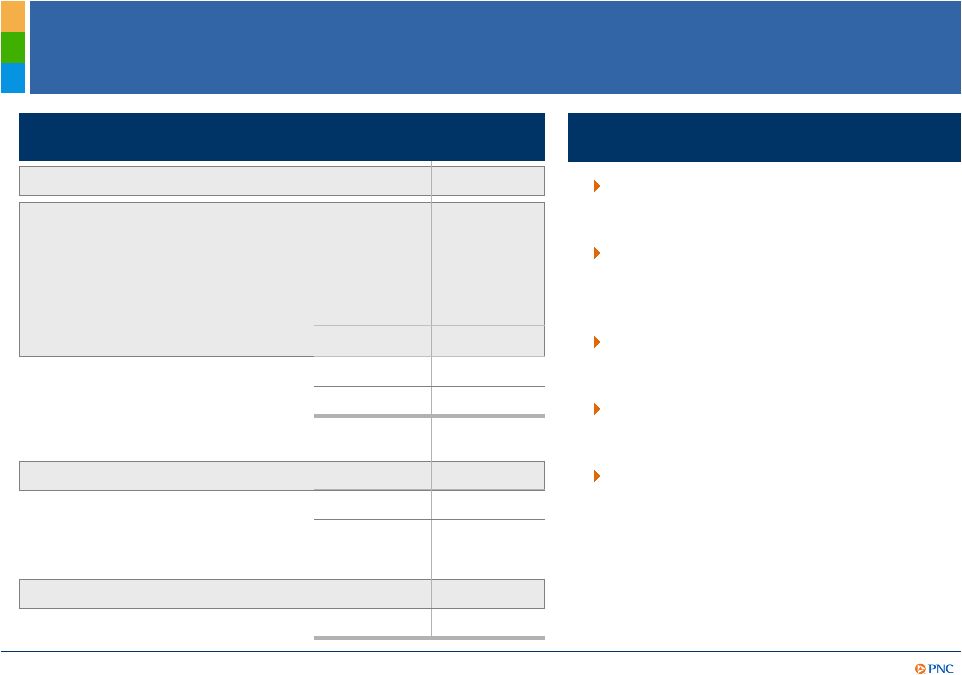 7
A Higher Quality, Differentiated Balance Sheet
Category (billions)
Mar. 31,
2011
Dec. 31,
2010
Investment securities
$61.0
$64.3
Core
commercial
loans
62.0
60.7
Core
commercial
real
estate
15.8
16.4
Core
consumer
loans
57.7
58.7
Distressed
loans²
13.9
14.8
Total loans
149.4
150.6
Other assets
49.0
49.4
Total assets
$259.4
$264.3
Transaction deposits
$134.5
$134.7
Retail CDs, time, savings
47.5
48.7
Total deposits
182.0
183.4
Borrowed funds, other
46.3
50.7
Preferred equity
.6
.6
Common equity
30.5
29.6
Total liabilities and equity
$259.4
$264.3
Securities impacted by principal
prepayments and sales
Core commercial loan growth offset
by continued distressed runoff and
soft consumer loan demand
Continued reduction in high cost
brokered and retail CDs
Core funded –
loans to deposits
ratio of 82%
Strengthened common equity
Highlights
(1)
Excludes
loans
assigned
to
the
Distressed
Assets
Portfolio
business
segment.
(2)
Represents
loans
assigned
to
the
Distressed
Assets
Portfolio
business
segment.
1
1
1 |
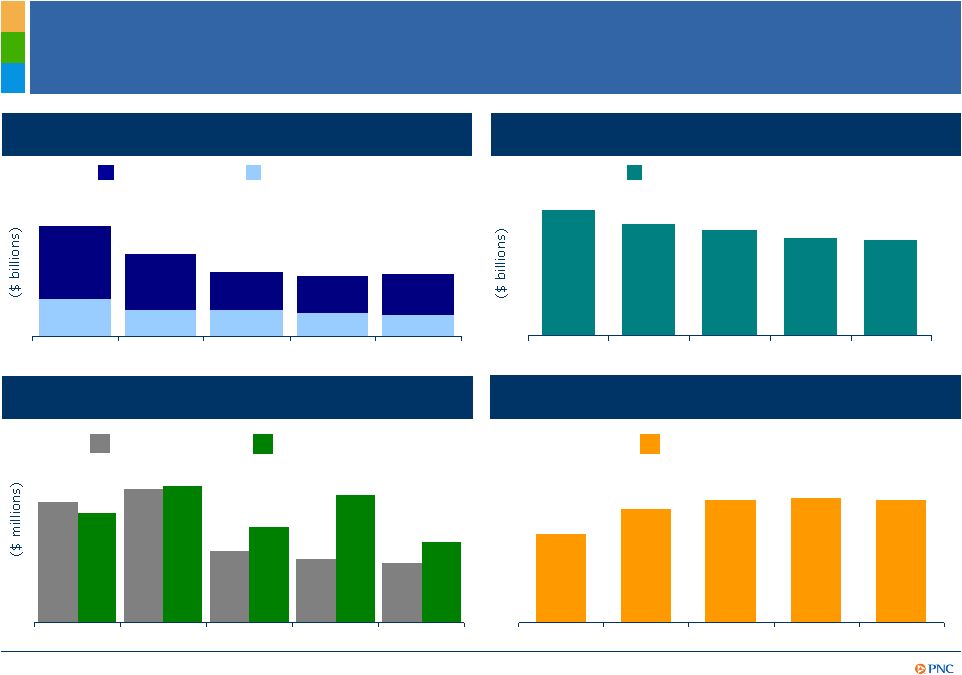 8
Credit Trends Continue to Improve
$751
$486
$442
$421
$840
$614
$791
$823
$691
$533
1Q10
2Q10
3Q10
4Q10
1Q11
Provision
Net charge-offs
Allowance to NPL’s
104%
92%
108%
109%
108%
1Q10
2Q10
3Q10
4Q10
1Q11
Provision and net charge-offs
Coverage
Accruing
loans
past
due
1,2
30-89 Days
90 Days +
Nonperforming
loans
1,3
$2.5
$1.9
$1.4
$1.4
$1.4
$.8
$.6
$.6
$.5
$.5
1Q10
2Q10
3Q10
4Q10
1Q11
1Q10
2Q10
3Q10
4Q10
1Q11
Total nonperforming loans
$5.8
$5.1
$4.8
$4.5
As of quarter end except net charge-offs, which are for the quarter. (1) Loans acquired
from National City that were impaired are not included as they were recorded at
estimated fair value when acquired and are currently considered performing loans due to the accretion of interest in
purchase accounting. (2) Excludes loans that are government insured/guaranteed, primarily
residential mortgages. (3) Does not include loans held for sale or foreclosed and other
assets. $4.4 |
 9
3.94%
3.96%
4.35%
3.93%
4.24%
3.43%
3.32%
3.38%
3.39%
3.45%
3.18%
2.88%
3.15%
3.10%
2.90%
1Q10
2Q10
3Q10
4Q10
1Q11
Net interest
margin
Provision-
adjusted NIM
5
Core
1
and
Provision-Adjusted
2
Net
Interest
Income
Trends
(1)
Core
net
interest
income
is
total
net
interest
income,
as
reported,
less
related
purchase
accounting
accretion
(scheduled
and
cash
recoveries).
(2)
Reflects
cash
received
in
excess
of
recorded
investment
from
sales
or
payoffs
of
impaired
commercial
loans.
(3)
Provision-
adjusted
net
interest
income
is
total
net
interest
income,
as
reported,
less
provision.
(4)
Net
interest
margin
less
(annualized
purchase
accounting
accretion/average
interest-earning
assets).
(5)
Net
interest
margin
less
(annualized
provision/average
interest-earnings
assets).
Further
information
on
(4)
and
(5)
is
provided
in
the
Appendix.
(millions)
1Q10
2Q10
3Q10
4Q10
1Q11
Core
NII
$1,939
$1,895
$1,890
$1,857
$1,895
Scheduled purchase accounting
accretion
365
376
214
211
200
Cash
recoveries
75
164
111
133
81
Total NII
$2,379
$2,435
$2,215
$2,201
$2,176
Provision
751
823
486
442
421
Provision-adjusted
NII
$1,628
$1,612
$1,729
$1,759
$1,755
Core NIM
4
Purchase
accounting
accretion
Provision
2
3
1 |
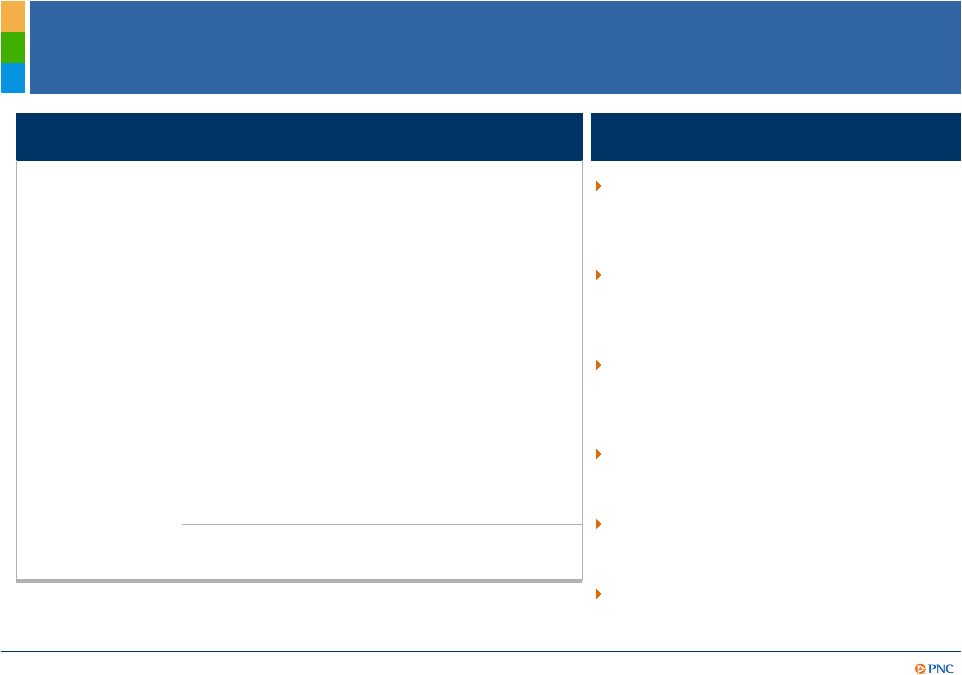  10
Client Growth and Sales Momentum Provide
Opportunities to Increase Noninterest Revenue
Highlights
(millions)
1Q10
2Q10
3Q10
4Q10
1Q11
Asset
management
1
$259
$243
$249
$303
$263
Consumer services
296
315
328
322
311
Corporate services
268
261
183
370
217
Residential
mortgage
147
179
216
157
195
Deposit service
charges
200
209
164
132
123
BlackRock
transaction gain
-
-
-
160
-
Other
2
214
270
243
258
346
Total noninterest
income
$1,384
$1,477
$1,383
$1,702
$1,455
Asset management fees impacted in
comparison by higher 4Q10 BlackRock
contribution. Strong Asset Management
Group contribution in 1Q11
Consumer services increased in 1Q11
versus 1Q10 due to customer growth and
increased volume; seasonal decline
versus 4Q10
Corporate services impacted by
commercial MSR impairment in 1Q11
versus recovery in 4Q10; strong M&A
advisory fees in 4Q10
Residential mortgage improved primarily
due to higher loan sales revenue and net
MSR hedging gains
Deposit service charges reflect
regulatory³
impact versus 1Q10 and
seasonal declines versus 4Q10
Other revenue increased versus 4Q10 due
to lower repurchase reserves in 1Q11
(1) Asset management fees include the Asset Management Group and
BlackRock (2) “Other”
includes net gains on sales of securities, net other-
than-temporary impairments, and other. (3) Regulatory impact reflects
Regulation E. |
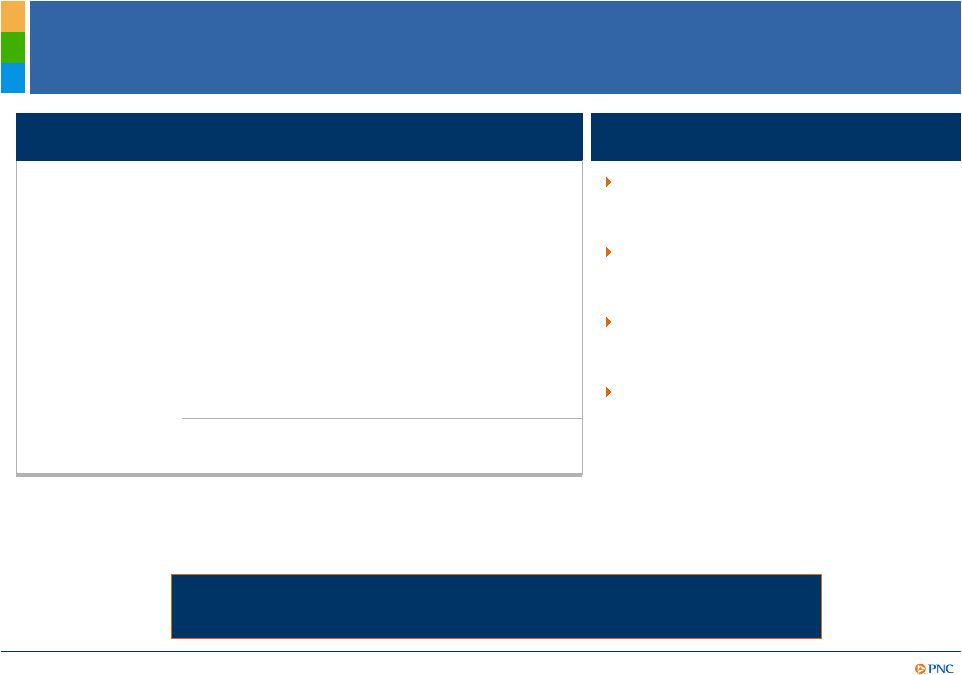  11
Well–Controlled Expenses While Investing for Growth
Highlights
$2,002
638
65
168
172
$959
2Q10
$2,158
789
81
152
177
$959
3Q10
$2,070
681
40
167
193
$989
1Q11
$2,340
$2,113
Total noninterest
expense
194
187
Occupancy
176
172
Equipment
70
50
Marketing
748
$956
1Q10
Other
Personnel
(millions)
868
$1,032
4Q10
Personnel expense declined versus 4Q10
primarily due to lower incentive
compensation
Marketing expense declined in 1Q11 due
to elevated costs associated with
launching in new markets in 2010
Other expense declined primarily due to
higher mortgage foreclosure expenses in
Q4
Expenses performed better than
expected in 1Q11 due to reversal of a
portion of indemnification liability for
Visa litigation of $38 million
PNC is Committed to Disciplined Expense Management.
PNC is Committed to Disciplined Expense Management. |
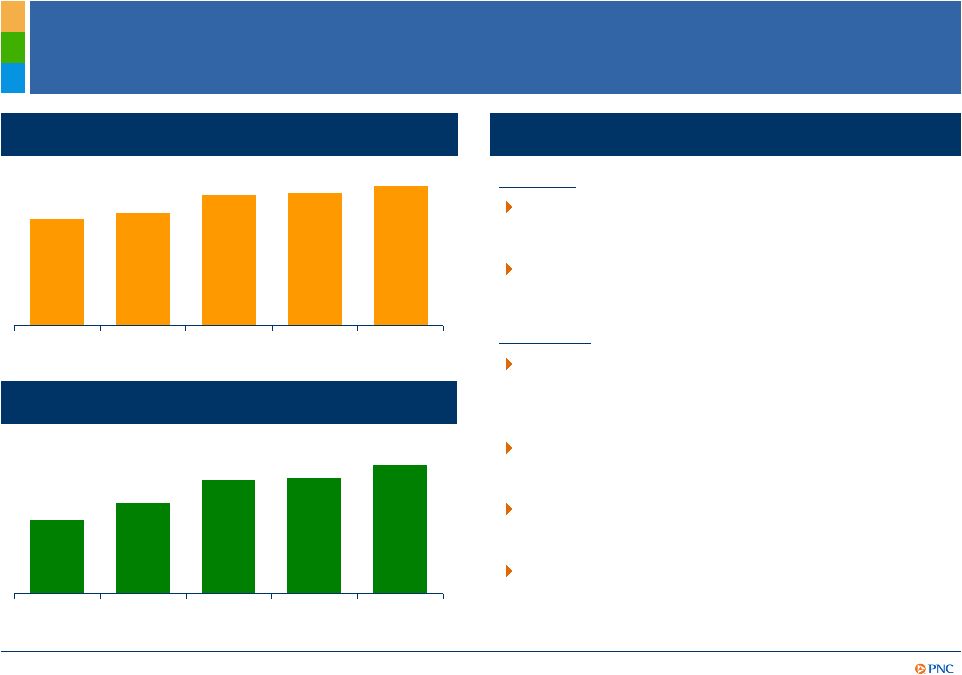 12
Strengthened Capital to Record Levels
Tier 1 common ratio and book value per share as of quarter end. (1) Estimated. (2) See note
(1) on Slide 4. PNC’s capital management actions / priorities
Actions:
Increased quarterly common stock dividend
250% to $0.35
for 2Q11
Confirmed share repurchase program; plan
to
repurchase
up
to
$500
million
in
2011
2
Priorities:
Maintain ample capacity to meet the needs
of our clients and support organic business
growth
Continue to invest in innovative products
and services
Deploy capital for acquisitions that meet
our strategic criteria
Ensure capital adequacy in times of
uncertainty and regulatory compliance
10.3%
9.8%
9.6%
8.3%
7.9%
1Q10
2Q10
3Q10
4Q10
1Q11¹
Tier 1 common ratio
$58.01
$56.29
$55.91
$52.77
$50.32
1Q10
2Q10
3Q10
4Q10
1Q11
Book value per share |
 13
Generating Solid Returns on a
Higher Quality Balance Sheet
ROAA highlights
Declining credit costs more than offsetting
reductions in purchase accounting accretion
Average assets declined $4.6 billion since
1Q10
3Q10
benefitted
from
gain
on
sale
of
GIS
2
Impact of higher earnings more than offset
by increased Tier 1 common capital
Tier 1 common capital increased 25% since
1Q10
3Q10
benefitted
from
gain
on
sale
of
GIS
2
1.29%
1.23%
1.65%
1.22%
1.02%
1Q10
2Q10
3Q10
4Q10
1Q11
Return on average assets
Return
on
Tier
1
common
capital
1
15.4%
15.4%
21.4%
17.7%
15.5%
1Q10
2Q10
3Q10
4Q10
1Q11
(1) 1Q11 Tier 1 common capital is estimated. Return on Tier 1 common capital calculated as
annualized net income divided by Tier 1
common capital. (2) See Appendix for 3Q10 returns as adjusted for the $328 million
after-tax gain on the sale of GIS. Further information on (1) and (2) is provided
in the Appendix. Return on Tier 1 common capital highlights
|
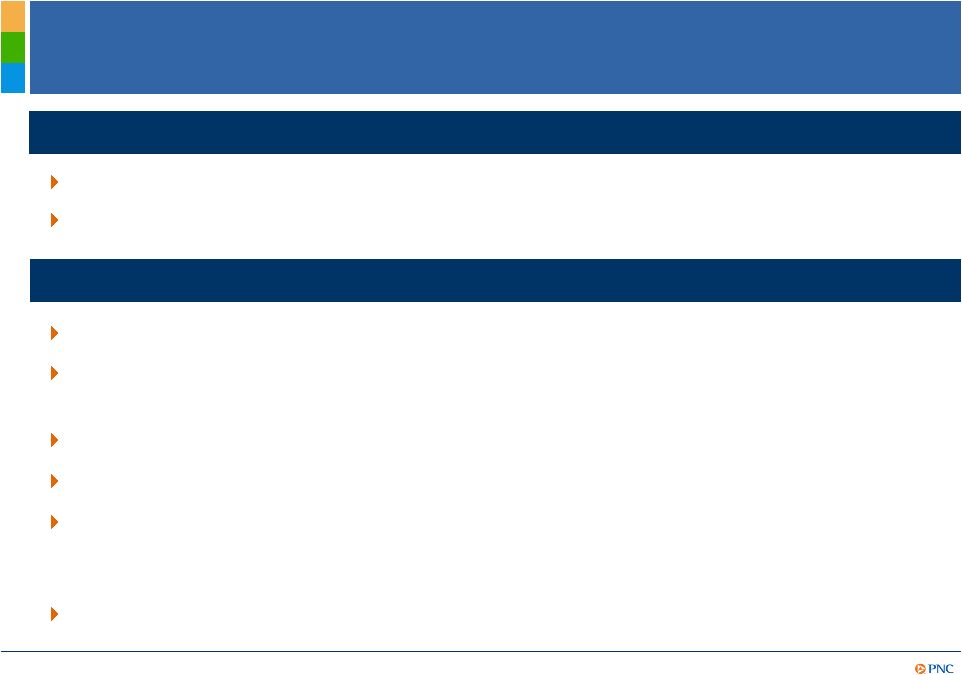 14
Outlook
1
–
Full
Year
2011
vs.
2010
Balance Sheet
Income Statement
Commercial loan growth is expected
Continue to shift deposit mix towards transaction accounts
Core NII expected to increase by more than $100 million
Purchase accounting accretion expected to decline by $700 million, resulting in
lower NII
Provision expected to decline by at least $800 million
Provision-adjusted NII and margin expected to increase
Noninterest income expected to increase in the low-to-mid single digits,
excluding the expected incremental negative impact of approximately $400
million due to overdraft and interchange regulatory limits
Noninterest
expenses
expected
to
decline
2
(1) Refer to assumptions in the Cautionary Statement in the Appendix. (2) Subject to legal and
regulatory contingencies. See Note 22 Legal Proceedings included in Item 8 and Risk
Factors Item 1A of PNC’s 2010 Form 10-K. |
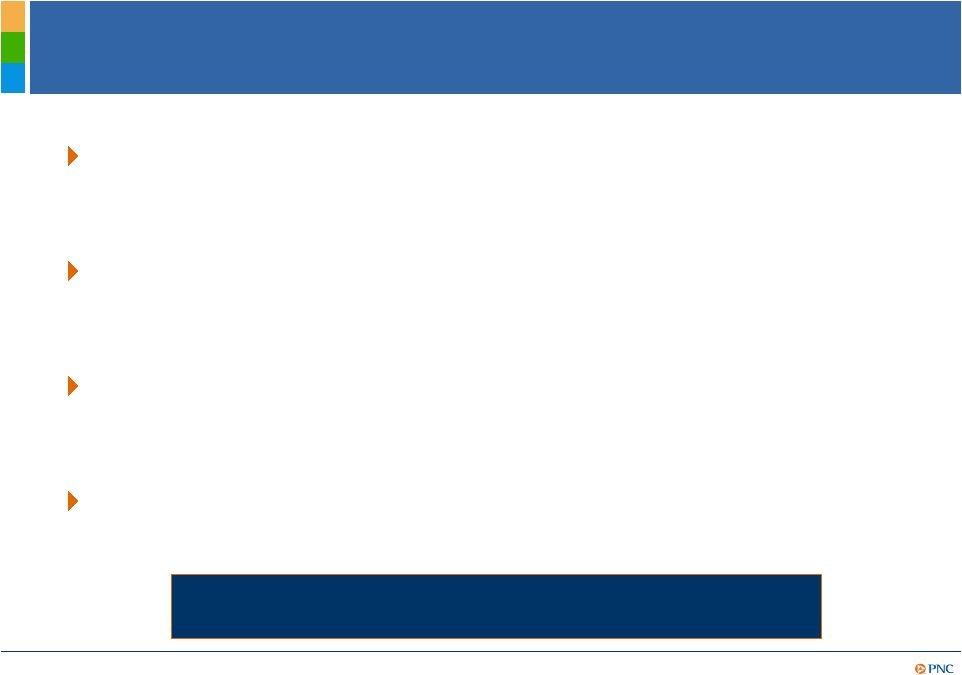 15
Summary
PNC Continues to Build a Great Company.
PNC Continues to Build a Great Company.
1Q11 strategic achievements –
strong results and
capital actions
Building momentum in our businesses –
client
growth and new product launches
Key financial take-aways –
strong balance sheet,
strong earnings and solid returns
2011 outlook remains positive |
 16
Cautionary Statement Regarding Forward-Looking
Information
Appendix
This
presentation
includes
“snapshot”
information
about
PNC
used
by
way
of
illustration
and
is
not
intended
as
a
full
business
or
financial
review.
It
should
not
be
viewed
in
isolation
but
rather
in
the
context
of
all
of
the
information
made
available
by
PNC
in
its
SEC
filings.
We
also
make
statements
in
this
presentation,
and
we
may
from
time
to
time
make
other
statements,
regarding
our
outlook
or
expectations
for
earnings,
revenues,
expenses,
capital
levels,
liquidity
levels,
asset
quality
and/or
other
matters
regarding
or
affecting
PNC
and
its
future
business
and
operations
that
are
forward-looking
statements
within
the
meaning
of
the
Private
Securities
Litigation
Reform
Act.
Forward-looking
statements
are
typically
identified
by
words
such
as
“believe,”
“plan,”
“expect,”
“anticipate,”
“intend,”
“outlook,”
“estimate,”
“forecast,”
“will,”
“should,”
“project,”
“goal”
and
other
similar
words
and
expressions.
Forward-looking
statements
are
subject
to
numerous
assumptions,
risks
and
uncertainties,
which
change
over
time.
Forward-looking
statements
speak
only
as
of
the
date
they
are
made.
We
do
not
assume
any
duty
and
do
not
undertake
to
update
our
forward-
looking
statements.
Actual
results
or
future
events
could
differ,
possibly
materially,
from
those
that
we
anticipated
in
our
forward-looking
statements,
and
future
results
could
differ
materially
from
our
historical
performance.
Our
forward-looking
statements
are
subject
to
the
following
principal
risks
and
uncertainties.
We
provide
greater
detail
regarding
some
of
these
factors
in
our
2010
Form
10-K,
including
in
the
Risk
Factors
and
Risk
Management
sections
of
that
report,
and
in
our
subsequent
SEC
filings.
Our
forward-looking
statements
may
also
be
subject
to
other
risks
and
uncertainties,
including
those
that
we
may
discuss
elsewhere
in
this
presentation
or
in
our
filings
with
the
SEC,
accessible
on
the
SEC’s
website
at
www.sec.gov
and
on
or
through
our
corporate
website
at
www.pnc.com/secfilings.
We
have
included
these
web
addresses
as
inactive
textual
references
only.
Information
on
these
websites
is
not
part
of
this
document.
•Our
businesses
and
financial
results
are
affected
by
business
and
economic
conditions,
both
generally
and
specifically
in
the
principal
markets
in
which
we
operate.
In
particular,
our
businesses
and
financial
results
may
be
impacted
by:
o
Changes
in
interest
rates
and
valuations
in
the
debt,
equity
and
other
financial
markets.
o
Disruptions
in
the
liquidity
and
other
functioning
of
financial
markets,
including
such
disruptions
in
the
markets
for
real
estate
and
other
assets
commonly
securing
financial
products.
o
Actions
by
the
Federal
Reserve
and
other
government
agencies,
including
those
that
impact
money
supply
and
market
interest
rates.
o
Changes
in
our
customers’,
suppliers’
and
other
counterparties’
performance
in
general
and
their
creditworthiness
in
particular.
o
A
slowing
or
failure
of
the
moderate
economic
recovery
that
began
in
mid-2009
and
continued
throughout
2010
and
into
2011.
o
Continued
effects
of
the
aftermath
of
recessionary
conditions
and
the
uneven
spread
of
the
positive
impacts
of
the
recovery
on
the
economy
in
general
and
our
customers
in
particular,
including
adverse
impact
on
loan
utilization
rates
as
well
as
delinquencies,
defaults
and
customer
ability
to
meet
credit
obligations.
o
Changes
in
levels
of
unemployment.
o
Changes
in
customer
preferences
and
behavior,
whether
as
a
result
of
changing
business
and
economic
conditions,
climate-related
physical
changes
or
legislative
and
regulatory
initiatives,
or
other
factors.
•Turbulence
in
significant
portions
of
the
US
and
global
financial
markets
could
impact
our
performance,
both
directly
by
affecting
our
revenues
and
the
value
of
our
assets
and
liabilities
and
indirectly
by
affecting
our
counterparties
and
the
economy
generally. |
 17
Cautionary Statement Regarding Forward-Looking
Information (continued)
Appendix
•We
will
be
impacted
by
the
extensive
reforms
provided
for
in
the
Dodd-Frank
Wall
Street
Reform
and
Consumer
Protection
Act
(“Dodd-Frank
Act”)
and
ongoing
reforms
impacting
the
financial
institutions
industry
generally.
Further,
as
much
of
the
Dodd-Frank
Act
will
require
the
adoption
of
implementing
regulations
by
a
number
of
different
regulatory
bodies,
the
precise
nature,
extent
and
timing
of
many
of
these
reforms
and
the
impact
on
us
is
still
uncertain.
•Financial
industry
restructuring
in
the
current
environment
could
also
impact
our
business
and
financial
performance
as
a
result
of
changes
in
the
creditworthiness
and
performance
of
our
counterparties
and
by
changes
in
the
competitive
and
regulatory
landscape.
•Our
results
depend
on
our
ability
to
manage
current
elevated
levels
of
impaired
assets.
•Given
current
economic
and
financial
market
conditions,
our
forward-looking
financial
statements
are
subject
to
the
risk
that
these
conditions
will
be
substantially
different
than
we
are
currently
expecting.
These
statements
are
based
on
our
current
view
that
the
moderate
economic
recovery
that
began
in
mid-2009
and
continued
throughout
2010
will
transition
into
a
self-sustaining
economic
expansion
in
2011
pushing
the
unemployment
rate
lower
amidst
continued
low
interest
rates.
•Legal
and
regulatory
developments
could
have
an
impact
on
our
ability
to
operate
our
businesses
or
our
financial
condition
or
results
of
operations
or
our
competitive
position
or
reputation.
Reputational
impacts,
in
turn,
could
affect
matters
such
as
business
generation
and
retention,
our
ability
to
attract
and
retain
management,
liquidity,
and
funding.
These
legal
and
regulatory
developments
could
include:
o
Changes
resulting
from
legislative
and
regulatory
responses
to
the
current
economic
and
financial
industry
environment.
o
Other
legislative
and
regulatory
reforms,
including
broad-based
restructuring
of
financial
industry
regulation
(such
as
that
under
the
Dodd-Frank
Act)
as
well
as
changes
to
laws
and
regulations
involving
tax,
pension,
bankruptcy,
consumer
protection,
and
other
aspects
of
the
financial
institution
industry.
o
Unfavorable
resolution
of
legal
proceedings
or
other
claims
and
regulatory
and
other
governmental
investigations
or
other
inquiries.
In
addition
to
matters
relating
to
PNC’s
business
and
activities,
such
matters
may
also
include
proceedings,
claims,
investigations,
or
inquiries
relating
to
pre-acquisition
business
and
activities
of
acquired
companies,
such
as
National
City.
These
matters
may
result
in
monetary
judgments
or
settlements
or
other
remedies,
including
fines,
penalties,
restitution
or
alterations
in
our
business
practices
and
in
additional
expenses
and
collateral
costs.
o
The
results
of
the
regulatory
examination
and
supervision
process,
including
our
failure
to
satisfy
the
requirements
of
agreements
with
governmental
agencies.
o
Changes
in
accounting
policies
and
principles.
o
Changes
resulting
from
legislative
and
regulatory
initiatives
relating
to
climate
change
that
have
or
may
have
a
negative
impact
on
our
customers’
demand
for
or
use
of
our
products
and
services
in
general
and
their
creditworthiness
in
particular.
o
Changes
to
regulations
governing
bank
capital,
including
as
a
result
of
the
Dodd-Frank
Act
and
of
the
Basel
III
initiatives.
•Our
business
and
operating
results
are
affected
by
our
ability
to
identify
and
effectively
manage
risks
inherent
in
our
businesses,
including,
where
appropriate,
through
the
effective
use
of
third-party
insurance,
derivatives,
and
capital
management
techniques,
and
by
our
ability
to
meet
evolving
regulatory
capital
standards.
•The
adequacy
of
our
intellectual
property
protection,
and
the
extent
of
any
costs
associated
with
obtaining
rights
in
intellectual
property
claimed
by
others,
can
impact
our
business
and
operating
results.
•Our
ability
to
anticipate
and
respond
to
technological
changes
can
have
an
impact
on
our
ability
to
respond
to
customer
needs
and
to
meet
competitive
demands.
•Our
ability
to
implement
our
business
initiatives
and
strategies
could
affect
our
financial
performance
over
the
next
several
years. |
 18
Cautionary Statement Regarding Forward-Looking
Information (continued)
Appendix
•Competition can have an impact on customer acquisition, growth and retention, as well as
on our credit spreads and product pricing, which can affect
market
share,
deposits
and
revenues.
•Our
business
and
operating
results
can
also
be
affected
by
widespread
disasters,
terrorist
activities
or
international
hostilities,
either
as
a
result
of
the
impact
on
the
economy
and
capital
and
other
financial
markets
generally
or
on
us
or
on
our
customers,
suppliers
or
other
counterparties
specifically.
•Also,
risks
and
uncertainties
that
could
affect
the
results
anticipated
in
forward-looking
statements
or
from
historical
performance
relating
to
our
equity
interest
in
BlackRock,
Inc.
are
discussed
in
more
detail
in
BlackRock’s
filings
with
the
SEC,
including
in
the
Risk
Factors
sections
of
BlackRock’s
reports.
BlackRock’s
SEC
filings
are
accessible
on
the
SEC’s
website
and
on
or
through
BlackRock’s
website
at
www.blackrock.com.
This
material
is
referenced
for
informational
purposes
only
and
should
not
be
deemed
to
constitute
a
part
of
this
document.
We
grow
our
business
in
part
by
acquiring
from
time
to
time
other
financial
services
companies,
financial
services
assets
and
related
deposits.
Acquisitions
present
us
with
risks
in
addition
to
those
presented
by
the
nature
of
the
business
acquired.
These
include
risks
and
uncertainties
relate
d
both to
the
acquisition
transactions
themselves
and
to
the
integration
of
the
acquired
businesses
into
PNC
after
closing.
Acquisitions
may
be
substantially
more
expensive
to
complete
(including
unanticipated
costs
incurred
in
connection
with
the
integration
of
the
acquired
company)
and
the
anticipated
benefits
(including
anticipated
cost
savings
and
strategic
gains)
may
be
significantly
harder
or
take
longer
to
achieve
than
expected.
Acquisitions
may
involve
our
entry
into
new
businesses
or
new
geographic
or
other
markets,
and
these
situations
also
present
risks
resulting
from
our
inexperience
in
those
new
areas.
As
a
regulated
financial
institution,
our
pursuit
of
attractive
acquisition
opportunities
could
be
negatively
impacted
due
to
regulatory
delays
or
other
regulatory
issues.
In
addition,
regulatory
and/or
legal
issues
relating
to
the
pre-acquisition
operations
of
an
acquired
business
may
cause
reputational
harm
to
PNC
following
the
acquisition
and
integration
of
the
acquired
business
into
ours
and
may
result
in
additional
future
costs
or
regulatory
limitations
arising
as
a
result
of
those
issues.
Any
annualized,
proforma,
estimated,
third
party
or
consensus
numbers
in
this
presentation
are
used
for
illustrative
or
comparative
purposes
only
and
may
not
reflect
actual
results.
Any
consensus
earnings
estimates
are
calculated
based
on
the
earnings
projections
made
by
analysts
who
cover
that
company.
The
analysts’
opinions,
estimates
or
forecasts
(and
therefore
the
consensus
earnings
estimates)
are
theirs
alone,
are
not
those
of
PNC
or
its
management,
and
may
not
reflect
PNC’s
or
other
company’s
actual
or
anticipated
results. |
 19
Non-GAAP to GAAP Reconcilement
Appendix
In millions
Adjustments,
pretax
Income taxes
(benefit)1
Net income
Average
Assets
Return on Avg.
Assets
Net income and return on avg. assets, as reported
$832
Reported net income, if annualized
$3,374
$262,554
1.29%
In millions
Adjustments,
pretax
Income taxes
(benefit)1
Net income
Average
Assets
Return on Avg.
Assets
Net income and return on avg. assets, as reported
$820
Reported net income, if annualized
$3,253
$263,558
1.23%
In millions
Adjustments,
pretax
Income taxes
(benefit)1
Net income
Average
Assets
Return on Avg.
Assets
Net income and return on avg. assets, as reported
$1,103
Reported net income, if annualized
$4,376
$264,579
1.65%
Adjustments:
Gain on sale of GIS
($639)
$311
(328)
Adjusted net income
$775
Adjusted net income, if annualized
$3,075
$264,579
1.16%
For the three months ended March 31, 2011
For the three months ended December 31, 2010
For the three months ended September 30, 2010
PNC
believes
that
information
adjusted
for
the
impact
of
certain
items
may
be
useful
due
to
the
extent
to
which
the
items
are
not
indicative of our ongoing operations.
(1)
Calculated
using
a
marginal
federal
income
tax
rate
of
35%
and
includes
applicable
income
tax
adjustments.
The
after-tax
gain
on
the
sale of GIS also reflects the impact of state income taxes. |
 20
Non-GAAP to GAAP Reconcilement
Appendix
In millions
Mar. 31, 2011
Dec. 31, 2010
Sept. 30, 2010
June 30, 2010
Mar. 31, 2010
Tier 1 common capital
$21,970
$21,188
$20,437
$18,173
$17,562
Reported net income
832
820
1,103
803
671
Reported net income, if annualized
3,374
3,253
4,376
3,221
2,721
Adjustments:
After-tax gain on sale of GIS
(328)
Adjusted net income
775
Adjusted net income, if annualized
3,075
Return on tier 1 common capital
15.4%
15.4%
21.4%
17.7%
15.5%
Adjusted return on tier 1 common capital
15.0%
As of or for the three months ended
PNC
believes
that
return
on
tier
1
common
capital
is
useful
as
a
tool
to
help
measure
and
assess
a
company's
use
of
common
equity
and
that
such
information
adjusted
for
the
impact
of
the
GIS
gain
may
be
useful
due
to
the
extent
to
which
that
item
is
not
indicative
of
our
ongoing
operations.
After-tax
adjustments
are
calculated
using
a
marginal
federal
income
tax
rate
of
35%
and
include
applicable
income
tax
adjustments.
The
after-tax
gain
on
the
sale
of
GIS
also
reflects
the
impact
of
state
income
taxes.
The
pre-tax
gain
on
the
sale
of
GIS
was
$639 million.
In millions
Adjustments,
pretax
Income taxes
(benefit)1
Net income
Average
Assets
Return on Avg.
Assets
Net income and return on avg. assets, as reported
$803
Reported net income, if annualized
$3,221
$264,366
1.22%
In millions
Adjustments,
pretax
Income taxes
(benefit)1
Net income
Average
Assets
Return on Avg.
Assets
Net income and return on avg. assets, as reported
$671
Reported net income, if annualized
$2,721
$267,148
1.02%
PNC
believes
that
information
adjusted
for
the
impact
of
certain
items
may
be
useful
due
to
the
extent
to
which
the
items
are
not
indicative of our ongoing operations.
(1) Calculated using a marginal federal income tax rate of 35% and includes applicable income
tax adjustments. For the three months ended March 31, 2010
For the three months ended June 30, 2010 |
 21
Non-GAAP to GAAP Reconcilement
Appendix
For the three months ended
$ in millions
Mar. 31, 2011
Dec. 31, 2010
Sept. 30, 2010
June 30, 2010
Mar. 31, 2010
Net interest margin, as reported
3.94%
3.93%
3.96%
4.35%
4.24%
Provision for credit losses
$421
$442
$486
$823
$751
Provision for credit losses, if annualized
$1,707
$1,754
$1,928
$3,301
$3,046
Avg. interest earning assets
$224,095
$223,795
$223,677
$224,580
$226,992
Annualized provision/Avg. interest earning assets
0.76%
0.78%
0.86%
1.47%
1.34%
Provision-adjusted net interest margin (1)
3.18%
3.15%
3.10%
2.88%
2.90%
For the three months ended
$ in millions
Mar. 31, 2011
Dec. 31, 2010
Sept. 30, 2010
June 30, 2010
Mar. 31, 2010
Net interest margin, as reported
3.94%
3.93%
3.96%
4.35%
4.24%
Purchase accounting accretion (1)
$281
$344
$325
$540
$440
Purchase accounting accretion, if annualized
$1,140
$1,365
$1,289
$2,166
$1,784
Avg. interest earning assets
$224,095
$223,795
$223,677
$224,580
$226,992
Annualized purchase accounting accretion/Avg. interest earning assets
0.51%
0.61%
0.58%
0.96%
0.79%
Core net interest margin (2)
3.43%
3.32%
3.38%
3.39%
3.45%
PNC
believes
that
provision-adjusted
net
interest
margin,
a
non-GAAP
measure,
is
useful
as
a
tool
to
help
evaluate
the
amount
of
credit
related
risk
associated
with
interest-earning assets.
(1) The adjustment represents annualized provision for credit losses divided by average
interest-earning assets. (1) Purchase accounting accretion is scheduled purchase
accounting accretion plus cash recoveries. (2)
PNC
believes
that
core
net
interest
margin,
a
non-GAAP
measure,
is
useful
as
a
tool
to
help
evaluate
the
impact
of
purchase
accounting
accretion
on
net
interest
margin. The adjustment represents annualized purchase accounting accretion divided by
average interest-earning assets. |
 22
Non-GAAP to GAAP Reconcilement
Appendix
In millions except per share data
Dec. 31, 2008
Dec. 31, 2010
Mar. 31, 2011
Dec. 31, 2010
Mar. 31, 2011
Common shareholders' equity
$17,490
$29,595
$30,485
Common shares outstanding
443
526
526
Book value per common share
$39.44
$56.29
$58.01
Intangible assets
$11,688
$10,753
$10,764
Common shareholders' equity less intangi
$5,802
$18,842
$19,721
Common shares outstanding
443
526
526
Tangible book value per common share
$13.10
$35.82
$37.49
174%
186%
As of
Change from Dec. 31, 2008 to
PNC
believes
that
tangible
book
value
per
common
share,
a
non-GAAP
measure,
is
useful
as
a
tool
to
help
evaluate
the
amount,
on
a
per
share basis, of intangible assets included in book value per common share.
|
 23
Peer Group of Banks
Appendix
The PNC Financial Services Group, Inc.
PNC
BB&T Corporation
BBT
Bank of America Corporation
BAC
Capital One Financial, Inc.
COF
Comerica Inc.
CMA
Fifth Third Bancorp
FITB
JPMorgan Chase
JPM
KeyCorp
KEY
M&T Bank
MTB
Regions Financial Corporation
RF
SunTrust Banks, Inc.
STI
U.S. Bancorp
USB
Wells Fargo & Co.
WFC
Ticker |
